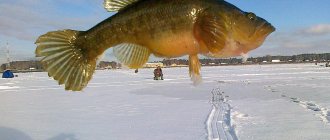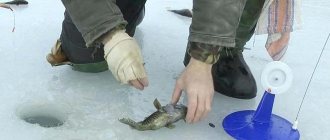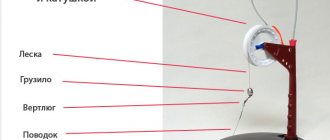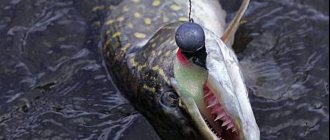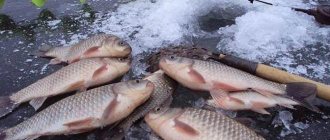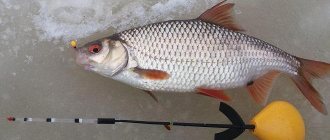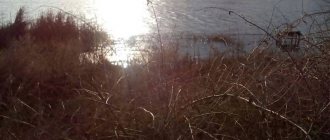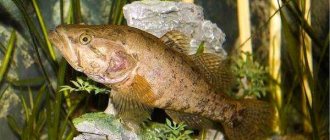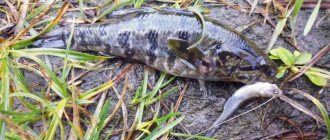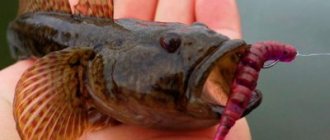What does rotan do in the spring?
In March, rotan behaves differently, depending on the reservoir and weather conditions. If the pond is clogged with it, and the oxygen level in the water is low, there is a lot of dead vegetation - very passive. In the case when the food supply in the reservoir is good, and at the same time a sufficient amount of oxygen with melt water gets under the ice, the rotan is activated, and you can hope for a good bite.
Food in March is zooplankton, bloodworms, small crustaceans, and the most favorite delicacy is juvenile rotan. In ponds, like pike, it is capable of forming stable perennial populations consisting of one species, completely exterminating all others. In winter it eats less than in summer. Typically a diurnal predator, it is inactive when the sun's rays do not fall under the ice. This can explain the passive behavior in January and February.
As spring approaches, the thickness of the ice decreases, more sunlight enters the water, and the fish become more active. In adult individuals, caviar and milt begin to ripen - this requires additional nutrition. Living stems of vegetation underwater begin to produce more oxygen. This also contributes to obesity.
Unfortunately, rotan is not a schooling fish, like perch or pike perch, but a solitary fish, like pike. Therefore, from one hole, bites of three or more specimens in a minute are an accident. However, if you return to this place after ten to fifteen minutes, you can catch a couple more pieces.
As underwater filming has shown, rotan's hunting pattern is ambush. He stands in the water near the thickets with his face up. When the bait is above his head, he makes a throw and grabs it. After this, it remains in the same position for some time, swallowing the bait, and then goes back into the depths. This is somewhat similar to the feeding of pike, only it rushes horizontally at its prey. But in March there are few stems, and the predator may change its habits.
Autumn, pond, rotan
It so happened that, having lived in the Moscow region for three years, I somehow never bothered to catch rotan, although even once I purposefully went out to one of the local ponds, but was left without a catch.
The pond where I was left without a catch.
And then one evening after work, my wife and I were walking through our village of Tomilino, and she said to me: “Let’s walk past the pond, we haven’t gone there for a long time.”
And, I must say, there are three ponds in the village, but the one I’m talking about is the most improved, it is rectangular in plan, one long side remains a flat bank, but the opposite side is half and the ends are completely reinforced with logs. True, the improvement was apparently done a long time ago, since the logs are already in a sad state.
Around the pond there is a walking path paved with paving stones, there are benches for vacationers and a children's playground. And during the warm season, a fountain with colored lighting is installed in the pond.
Beauty, in general!
Tomilino, central pond.
So, Lena and I are walking along the path, and then I notice a man with a spinning rod!
The fact is that fishermen with floats sit along the perimeter of the pond more or less regularly; one winter I even saw a “penguin” on the ice, but that was an isolated case, and I thought that the person simply decided to explore a new body of water. Since such precedents were no longer observed, I came to the conclusion that there was nothing worthy of attention in this reservoir.
And, suddenly, you’re wearing a spinning rod!
I, of course, understood that he was catching rotan, I had no information about the presence of another predator in the pond, but rotan is everywhere in the Moscow region, in almost every pond. I understood, but a glimmer of hope still glimmered somewhere inside, but how is there a perch here?
A miracle did not happen - there were no perch in this reservoir...
But while I was talking to the man, I watched how he caught, learned, and understood what my mistake was that time when I was left without a catch.
He was fishing with a “wacky”, I understood this immediately when I went down to him. The worm gliding in the water column was clearly visible, firstly because it was some kind of light, dirty-gray color, and, secondly, this “idiot” was already almost at the very shore, the distance to it was no more than three meters. And during communication, a third thing happened. The silicone worm in the water began to move from side to side, as if someone was pushing it. Naturally, it wasn’t as if it was the bait that was being attacked by rotan, which was hard to see in the muddy water at first, but after looking closely, I did see this robber. The hook was hooked, and after a little resistance the fish found itself above the water, but, fluttering on the bait, it fell back into the water. All! It's decided! Tomorrow after work I’ll take my spinning rod and head to the pond!
Logs.
And then the evening of the next day came. Fortunately, it takes seven minutes to walk from my office to my house, and five minutes from my house to the pond. In your hands - Aiko Margarita Mr-II-180UL-S, in your backpack - a Shimano Catana 2500 FB reel with a 0.08 monk and two packs of baits, Kinetic Custom Worms 2.75″ from the Chinese manufacturer Rosy Dawn and Troutino 2.5″ from Lucky John.
Caught a fish!
Well, go fish!
I make a cast and repeat the movements that I observed from yesterday’s fisherman - a couple of gentle jerks, just to make the worm bend on the hook and then a long pause. Rewinding the slack line, a couple more tugs and wait...
So what? And they waited! On the fourth or fifth cast there was a noticeable “knock” at the other end of the line and then the bait began to twitch. Chews! But, either he chewed it badly, or I was too hasty with the hook, and, most likely, the latter, I really wanted to quickly catch the first rotan in my life, but “a net came with sea grass.” I didn’t make any concessions to the second rotan, I honestly waited until he chewed on my worm and hooked me! And here it is - the first rotan!
The first rotan!
I have seen many times that this fish is photographed by being grabbed by the lower lip like a bass, but my first one seemed too small to me for such an action, and I made a portrait of it on a log.
Only later, having released the bandit back into the pond, I examined the frame and realized that it was necessary, after all, to photograph the “Russian bass” exactly in the form in which the majority do it. However, it looks more impressive with its fins spread out in all directions.
The biggest.
So, having caught a couple of rattans with each of the two baits in a little over an hour, and leaving one pink tadpole from Lucky John in a hook at the bottom of the pond, I ended the day.
I was cold as a dog - the last day of September turned out to be cold and windy, but I was happy as an elephant!
Where to fish in March
The usual habitat is small overgrown ponds, poor in oxygen. Apart from rotan, only crucian carp can survive in such conditions. This fish is absolutely not found where there are perch and pike, which instantly exterminate its population. By the way, this is a good way to get rid of it in a reservoir or reduce its population.
The depth at the fishing site usually does not exceed five meters. The author of the article fishes near the house in an old clay quarry on four, and there the fish bite throughout the entire thickness of the water. It usually stays near overgrown areas, where there are plants in the green phase, such as hornwort, under the ice. Where there are a lot of dead stems, rotan does not really like to stand in winter.
Two-meter areas should be considered promising, considering the thickness of the ice. Fishing for rotan from the ice in March is productive here. The depth can be difficult to determine, since the bottom is filled with a thick layer of algae, where rotan lives. In shallow places it is generally impossible to fish in summer - the water turns into a continuous swamp from a suspension of hornwort and elodea to the surface. The latter is an invasive species and is the main cause of overgrowing of water areas. After a long winter, dead stems sink to the bottom, freeing up free space under the hole.
Fishing for rotan in June
In each summer month, the behavior of rotan changes as the ambient temperature increases (decreases). Fishing for rotan in June is the most promising. But the period of active biting depends on the time of completion of fish spawning. It is long lasting and can last until the middle of the month.
After completion of spawning, the predator “sick” for 10-14 days. Females return to their habitats, and males during this period remain in the spawning grounds until the fry appear, which often become the prey of their “caring parent.” The rotan begins its post-spawning zhor.
During times of high activity, the predator can be found throughout the entire reservoir, with the exception of areas with fast currents. It bites on various artificial baits and lures. In the coastal zone, summer girders can be used. If the characteristics of the reservoir allow, then elastic tackle is successfully used.
Where and how to look
The fish bite from all over the ice area. Considering the nature of the reservoir, it is not possible to fish near the bottom, lowering the bait onto it - you will have to constantly drag the grass. The game with bait starts from the top and is gradually lowered until the moment where a hook occurs. After this, it is freed from the grass, raised a little and the game continues near the very edge of the plants. If there is no result, make wiring up and down throughout the entire thickness. Rotan can be located at any depth, and the deeper it is, the more difficult it can be to find, and the more time it takes for each hole.
Where to look for rotan in spring
The question of where to look for rotan in the spring is irrelevant when catching it on small lakes and ponds. In small bodies of water it can be found everywhere. In such conditions, the fish rarely gains weight up to 100 g, and fishing for rotan is usually carried out with the aim of catching live bait. Its natural enemies bite well: pike, perch and other types of predatory fish.
Rotana weighing from 300 g should be looked for according to the following criteria:
- Before the ice melts, you should focus on protruding islands of reeds and shallow water near the edges of ice that is still safe for fishing;
- Coastal shallow areas overgrown with algae;
- Algae boundaries with open bottom surface;
- Coastal edges at a depth of two meters, at a distance of 4-10 m from the shore;
- Windows in emergent vegetation;
- Artificial and natural bottom barriers behind which predators set up ambushes;
- Spawning grounds for other fish species.
It should be taken into account that rotan avoids fast currents, rapids on small rivers and areas with a hard bottom without the presence of algae.
When the ice melted
After this, fishing for rotan in the spring continues. The bite is becoming more and more active, reaching its peak in May-June. Traditionally they are caught using a float, spinning rod, or summer jig. Fishing with bottom gear is not used. In the spring there is much less grass thickets, so fishing is much more comfortable than in the summer.
Before fishing, you need to put a thick line and a large hook. This kind of fishing line is needed to pull out hooks. However, care must be taken to ensure good bite registration. If you hook prematurely, the trophy will go away and then won’t be caught for a long time. And if you’re late, you’ll have to fuss for a long time, removing the fish. That is why you need to take an extractor every time. If it is not there, rough tackle will allow you to simply pull out the throat, which can then be baited and caught.
Catching rotan in spring
It's spring, it's already warm outside, but at night the temperature drops to 2-5 degrees Celsius, so spending the night by a river or lake without a fire is simply unthinkable. The rivers have not yet entered the banks, although some fishermen go out with one hook (according to the rules of spring fishing, which may differ in different regions) and successfully catch with a worm or caddis, roach and bleak. And the perch bites, but not as often and greedily as we would like. What to do if you want to fish for predators in the spring? It’s simple - go for spring rotan.
Finding rotan in the spring is easy: just visit rotan lake and immediately start fishing. You don’t need a long rod, since in the spring (in principle, in the summer too) rotan prefers to stay close to the shore, and sometimes it was possible to catch fish under 300 grams literally from a depth of 50 centimeters. The optimal rod would be no more than 5 meters. Line - 0.22-0.3 mm, hook with a long shank and float. The tackle for rotan does not shine with any grace, but this in no way affects the bite. An ordinary worm is used as bait. Note that fishing in the spring with rotan is popular, i.e. I have to look for fish. The term SEARCH does not mean the search for fish itself, but the search for test specimens, since if there is a rotan in the lake, then it will definitely bite. But the trouble is that even a small fish the size of a little finger can literally swallow the hook “to the tail”; you have to spend a lot of time removing it. So you have to wander from one place to another. As soon as small rotan starts to come across, and if within 10-15 minutes the small things continue to attack the worm, it is better to change the place. Please note that you can return to the original place after some time and pull out a decent fish. This is explained by the fact that a large rotan can approach a place where small things are actively swarming.
When fishing for rotan, long casting is not required. Often, in the spring, rotan is caught 2-3 meters from the shore, especially good if the entire coastal zone is littered with branches and reeds. These are just the favorite stopping places for rotan. After throwing the tackle, you need to wait about a minute, if there is no bite, move the float a little, repeat this manipulation several times. Rotan needs to be provoked to attack. Rotan bites hard and quite actively, but sometimes its bite is not detected at all. And if you hesitate to bite, then, most likely, the hook will be swallowed. In order not to waste time while fishing, you need to prepare several leashes with hooks in advance, and simply cut off the swallowed hook. At home or after fishing, you can get the hook. As a rule, in the spring the rotan bites so that hooking is practically not required - you notice the movement or immersion of the float, feel free to drag the tackle to the shore, in 90% of cases the rotan will be hooked. You can catch a long time with one worm. There is no need to hide the hook point, the main thing is that there is at least a piece of worm on the hook, and don’t forget about constant twitching - this is the key to successful rotan fishing.
Rotan meat is white, tasty, and there are almost no bones. If you manage to catch large fish, you are guaranteed an excellent fry. Moreover, rotan meat, in our opinion, is sometimes even more pleasant in taste than perch meat, but this, as they say, is our personal opinion. Rotana can be fried, dried, dried, and even smoked.
So, keep in mind that in the spring you can go fishing quite actively and effectively by filling the fish tank with black rotans, and sometimes the bite is such that you simply don’t notice the surrounding reality. It seems like an hour has passed, but in reality the fishing has been going on for three hours already.
Rotan fishing will be especially interesting for novice fishermen, since finding a lake or pond with rotan is not a problem, and on a good spring day, a bite will be guaranteed.
Tackle, bait and fishing methods
On the last ice, as throughout the winter, this fish is caught using jig tackle, vertical spinners and winter girders. All these methods work with varying degrees of success. It is better to select suitable equipment not at home, before fishing, but already on the pond.
Sheer lure
For vertical trolling of this fish, a tackle consisting of the following parts is used:
- A short fishing rod 30-50 cm long with a built-in reel with a diameter of 3-3.5 cm;
- A short nod made of nipple rubber, a spring or bright insulation;
- 10-meter winding of monofilament with a cross-section of 0.14-0.18 mm.
There is no point in reducing the diameter of the fishing line; this factor has little effect on the bite of rotan. But when fished out, the bunt offers serious resistance.
Among the baits, rotan is most actively caught using narrow and small perch spinners no more than 60 mm long and weighing 10-12 grams.
As an alternative to spinners, you can use silicone baits of similar size - small twisters, crustaceans and vibrotails.
To increase the attractiveness of vertical spinners for rotan, red woolen threads, glass beads, and artificial silicone bloodworms are placed on its hooks.
The technique for catching rotan with a spoon is not much different from that used for perch. The main feature of spring fishing for rotan is the constant drilling of a series of holes followed by fishing 5-6 lifts. Playing with bait includes sharp lifting of the spoon with wrist strokes with pauses lasting from 2 to 3-4 seconds.
Fishing with girders
When fishing for rotan in the winter, you can catch quite large specimens weighing up to 1 kg or more. In this case, the standard pike rate is re-equipped as follows:
- 10-12 meters of monofilament with a thickness of 0.25-0.27 mm are wound onto the reel of the girder;
- A small sliding sinker weighing 4-6 grams in still water is placed on the fishing line, 8-10 grams in the presence of a current;
- After the sinker, a small swivel is tied to the fishing line;
- A leash and a 15-centimeter leash made of monofilament with a cross-section of 0.22 mm with a double or tee attached at the end are attached to the swivel.
Recommended reading: Bream fishing in autumn
When fishing with a girdle, not only live bait is used as bait, such as bleak, perch, blue, but also pieces of smoked lard, chicken skin, large worms, and a bunch of bloodworms.
They place the girders on the last ice in a line with an interval of 5-7 meters or in 2 lines in a checkerboard pattern. The distance between two rows of gear should be at least 7-8 meters.
Despite the effectiveness of catching rotan with fry, this predator itself can become an excellent live bait. The fact is that pike is clearly partial to this species. If there is an opportunity to catch rotans before catching pike on the girders, it is clearly worth doing.
Winter fishing rod with jig
The most common and catchy one when fishing for rotan in March is jig tackle, which is equipped with the following parts:
- A small fishing rod with a reel and handle, a hard whip;
- 8-10 meters of monofilament with a cross section of 0.12-0.14 mm;
- Lavsan nod 10-15 cm long.
The baits used for fishing with this type of tackle are large and weighty jigs such as “Ball”, “Drobinka”, “Kaplya”, “Uralka”, “Witch”, “Devil”. Jigs that have a golden or silver color are more catchy.
As bait for catching rotan with a jig, a bunch of bloodworms, pieces of chicken skin, and a worm are used. This voracious predator less often attacks maggots and burdocks. This fish is absolutely indifferent to plant baits.
The technique for catching rotan with a jig includes standard lifting of the bait from the bottom. They are accompanied by mid-frequency oscillations and pauses every 25-30 cm. As with catching perch with a nod, retrieving a high-raised bait from the upper horizon back to the bottom is often successful.
Catching rotan in the spring - hunting for a hungry raptor
In spring, rotan readily bites on silicone worms
Rotan is a voracious predator that never feels full. It reproduces very quickly and grows just as quickly. This is very pleasant for our fishermen, because catching rotan is a pleasant pleasure. There is no weather in which rotan would not bite, but still warm, sunny days are more to his taste. Considering that anglers go to the river mainly on clear days, catching rotan in the spring will be a very productive activity. If someone thinks that rotan is only suitable for cat food, then he definitely hasn’t tried cooking rotan in tomato sauce. Properly prepared rotan will be a very tasty “delicacy”. If you are interested in the history of its appearance in our reservoirs, the main means of fishing and habitats, see the article about sleeper on our website, or follow the link at the end of the article, or look in the “Fish” section. Now let's see how to catch it in the spring.
Rotan habitats
TO PECK THE HABITATS
The middle zone of our country is rich in reservoirs and lakes, rivers and streams, man-made ponds and quarries, from which sand and gravel were once taken for construction sites and roads. The temperate climate, abundance of food, and fairly clean water created excellent conditions for the life and reproduction of fish. In recent years, the one that has adapted best to these conditions in recent years is the uninvited and unexpected guest, who has already become the host in many places - the rotan. It is everywhere - “from Moscow to the very outskirts” of the Moscow region and beyond - in all four directions of the horizon. Where can a resident of the capital, for example, catch rotan?
From Yaroslavsky station, trains go to Fryazevo, from where you can take a bus to Vsevolodovo and Pavlovsky Posad. If you want, go to Fryazino. Get off the train at Fryazino Tovarny and you will find yourself at the lake, which the locals call the Great. If the bite is bad, go to the Barsky Pond. There is a beautiful estate, a church, and the pond itself is very picturesque. From the Yaroslavsky station you can get to Mytishchi and Monino, Sergiev Posad and Aleksandrov, and there you can find your way with the help of local fishermen. On the way to St. Petersburg, fishing in Reshetnikov leaves an indelible impression, from where, probably, no one has ever returned without a catch.
But from the Belorussky station you can get to the Golitsyn and Portnovskaya stations, get to the Kubinka area and near Dorokhov. By purchasing a ticket at Kursky Station, you will get to the Kupavna ponds. From here you can get to Elektrougli and near Serpukhov, and for those who like long journeys, to the ponds in Pakhomovo and Shulgin. It’s easy to take the Gorky Railway to the well-known Petushki, to the ponds that the ubiquitous sleeper devastated during its aggressive invasion in the first place.
You can easily reach the bays and ponds stretching along the Moscow Canal, the quiet backwaters of the Skhodnya River and the ponds surrounding the Istra Reservoir along the Rizhskaya Road, and from the Kazansky Station there is a direct route to Malakhovka. There are many of them - reservoirs - both near ancient Kaluga, and in quiet Meshchera, and on the Central Russian Upland. Even in Moscow itself you can catch rotans in Sokolniki and Izmailovo, in Cherkizovo and Krasnaya Presnya.
Did you take the fishing rods? Bait with you? Just be sure to transport fishing rods in covers or cases. This will protect them from damage on trains and buses, when traveling on foot along winding roads and overgrown paths.
Catching rotan in the spring - what to catch?
What should you use to catch rotan? The choice of gear is obvious, and it will be most convenient to catch it in these ways:
So, let's look at the pros and cons of each gear.
Float rod
The most obvious leader among other gear. To catch rotan, you should choose a light float rod that will be convenient
lie in your hand. Since long casts are not expected, its length is not particularly important. Choose a rod that you feel comfortable with. Rotan switches frequently and sharply, so you will have to move a lot. It is not even necessary to equip the rod with a reel; to lighten the weight, you can get by with a simple piece of fishing line tied at the end.
The fishing line should not be particularly thick, about 0.2 mm, however, if you find yourself on a pond by accident and only have a thick fishing line at hand, it doesn’t matter, it will do. The size of the hook is also not particularly important, but you should not use very large hooks - rotan likes to swallow the bait whole, so take a No. 3 or No. 4 hook.
Fishing with a jig
No special cunning is required here - you hook a bright jig and make any movements with it - the rotan will rush at it without hesitation. There have been cases when rotan was caught on a hook painted black. But I would still recommend attaching a worm to the hook.
We catch roton on a donk.
Donka fishing is not particularly tricky, and you can’t give any special advice here. Choose a sinker that is not too heavy; nevertheless, the specifics of the reservoir dictate its own. It will be more convenient to fish with a bottom fishing rod. For equipping a bottom fishing rod, the tips given above are suitable.
There is no point in feeding rotan; it already takes it very greedily in the spring. But if you want to lure more individuals, you can use everything - cut worms, bloodworms, maggots, pieces of meat - use everything that can attract this predator. He especially likes the “smell” of blood.
In spring, such individuals are often found
Weather and parking areas
As I said, rotan especially loves sunny weather, but it doesn’t stop biting in any other weather. In calm weather, you should “move” the float a little. This is explained by the fact that rotan loves moving objects. He peers for a long time from his hiding place, and then makes a quick dash, simultaneously swallowing the bait deeper. You can also sometimes “twitch” the hook, as when trolling. Take this feature into account and the bite will be excellent. In windy weather there is no particular point in such a maneuver - the wind will “drive” the float from side to side, allowing the bait to move.
In the end, it is worth noting one more feature of rotan - if suddenly it falls off your hook, then do not be upset, it has not gone anywhere - lower the hook to the place where it fell, and after a while it will be on the hook again.
Sources:
https://fishelovka.ru/fish/rotan-osobennosti-ljubitelskoj-lovli-vesnoj https://fishx.org/lovlya-rotana-vesnoy/ https://na-zorke.ru/sposoby-lovli/lovlya-rotana -vesnoj.html
All about rotan
Rotan prefers thickets or rubble of snags rather than open spaces. He cannot be called an active hunter, since he does not particularly pursue his prey. If he gets off the hook, he will certainly return to the same place, suspecting nothing. Unfortunately, this fish can happily feast on its fellows.
Rotan does not grow more than 25cm, which depends on growth and feeding conditions. Its optimal size is within 14 cm, and its life expectancy is about 7 years. As a rule, he does not live more than 4-5 years, although he can live longer.
Habitat of rotan
At first it could be caught in the Amur River basin, in the Far East, northern North Korea and northeastern China.
At the beginning of the twentieth century, it ended up in the Lake Baikal basin, which scientists called biological pollution.
It appeared in the reservoirs of St. Petersburg in 1916, after which it began to quickly spread throughout northern Eurasia and European countries.
To date, it has been spotted in the basins of the Volga, Dnieper, Dniester, Irtysh, Danube, Ob, Stir, and Ural rivers. Prefers reservoirs in which there are no predators capable of hunting rotan. It is spread by humans and also spreads between water bodies during floods. Able to survive in the dirtiest bodies of water, it is not afraid of freezing, since after thawing it can come to life.

